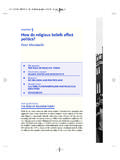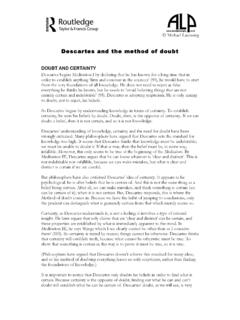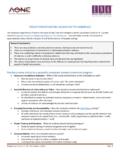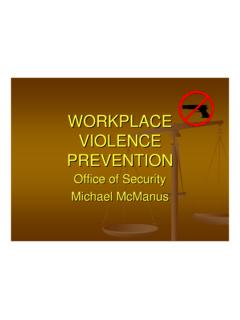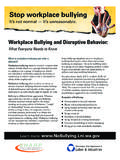Transcription of Case: U.S. Postal Service and Workplace Violence
1 Case: Postal Service and Workplace Violence Roy Betts, media relations representative for the Postal Service , stands in the little square-shaped cubicle that is his office and disseminates information about the new electricity-powered Postal Service trucks. If his cube had been situated just a bit differently, he could see a magnificent view of Washington, DC, from the office windows of the headquarters building nicknamed the Pink Palace, but he is not concerned with views just now. In addition to the outgoing news on trucks, he is thinking about a story already in the local papers about a gunman on a rampage in San Francisco. My first thought when I heard about it, he says, was I hope he's not a Postal employee.'. But even though he's not, I guarantee you I will get at least one phone call from the news media about the incident.. Many Postal Service employees are experts on Violence , particularly Workplace Violence . Between 1983 and 1993, there were 10 incidents of Violence in which Postal employees or former Postal employees murdered 34 people, most at a work site.
2 The most notorious incident staff members simply called Edmond. Part-time letter carrier Patrick Sherrill, about to be terminated from the Edmond, Oklahoma, Post Office, brandished a gun and shot 14 people. When it was over, all of them were dead, and Sherrill killed himself. It was August 20, 1986. Edmond, said Betts, seemed to be a bizarre, rare incident. I believe institutions, like individuals, go through a period of denial before reality sets in. The Postal Service was in denial after Edmond, but Royal Oak shocked us into reality.. The Royal Oak incident happened on November 14, 1991, when Postal employee Thomas McIlvane killed four people in the Royal Oak, Michigan, Post Office, injured eight others, and killed himself (see Fig. ). 2011 Taylor and Francis Once the trigger is pulled, you've lost; the battle is over, Betts said. You go through post trauma and then do what you can to prevent another incident.. You can't erase the incident from people's minds or delete words from the media.
3 The media are very interested whenever there's an incident of Violence .. (Examples of Postal Service communications with employees and the media are shown in Figs. and ). Following the Royal Oak incident, the Postal Service issued its Joint Statement on Violence and Behavior in the Workplace to Postal employees (see Fig. ). It was a response, not only of Postal Service management, but also of the unions and the management associations all working together to prevent further tragedy. In the early 1990s, departments reported to then-Postmaster General Marvin Runyon. Each department somehow dealt with the issue of preventing Workplace Violence . Betts reported to Frank Brennan, the manager of media relations, who reported to corporate relations vice president Larry Speakes (yes, the same Larry Speakes of the Reagan administration), who reported to Runyon (see Fig. ). Among its other duties, the media relations department was faced with getting information to the media and to employees about Violence - prevention programs.
4 It was also instrumental in keeping the media away from grieving employees, families, and eyewitnesses to incidents of Violence . 2011 Taylor and Francis 2011 Taylor and Francis 2011 Taylor and Francis Ann Wright, manager of employee health and services , collaborated with others to set up the national strategy for Violence prevention . Dave Cybulski, manager of management association relations, served as a liaison with four principal unions of Postal workers and three management associations. Workplace Violence became a point of unusual accord between the labor associations and the Postal Service . We have very collegial relations with the unions on this issue, said Cybulski. 2011 Taylor and Francis Postal Service Employee Relations Specialist Bradley Johnson was hired by Suzanne Henry, former vice president of employee relations, to coordinate all the various Violence prevention efforts. He was responsible for the development and implementation of the Postal Service 's corporate strategy on prevention programs for Workplace Violence .
5 Johnson developed a leadership awareness program on Workplace Violence prevention for 40,000 supervisors, managers, postmasters, and local union officials. Regarding the program, Johnson said, The issue is too massive and the credibility of the program too important for me to do it alone. So, I. consulted with several of the nation's leading clinical psychologists. These 2011 Taylor and Francis consultations provided me with the strategic direction and foundation for the development of this program.. Ask any one of them about the Violence and you will be told that the incidents, although tragic, are not as common as they seemed. The Postal Service is the largest civilian employer in the United States (at times, General Motors is larger), with 730,000 employees. With that many employees, problems develop, conflicts occur, and Violence can happen. The media, even today, still seem especially interested in incidents that take place in post offices. The crimes committed by Postal workers make much greater food for the news-hungry reporter than crimes committed against Postal workers.
6 Mail carriers are mugged, shot, stabbed, and bitten by dogs, but rarely do these incidents make news. At the same time, crimes committed at non- Postal work sites may be unreported, underreported, or reported as something other than Workplace Violence by the media. Cybulski noted one such tragedy in which an irate airlines employee 2011 Taylor and Francis walked onto a plane, shot his supervisor, and caused a fatal crash. The story was reported as a plane crash, but the incident was also an act of Workplace Violence . Then-Postmaster Runyon maintained that, despite the news media's concentration on Postal issues, the Postal Service had a lower rate of violent worker death than industry in general (Fields, 1993). Betts said the staff thinks of the Postal Service as a family operation despite its large number of employees. He said: At some point in time, somebody in every family works for the post office. Most of the Postal workers are mail-handlers sorters, clerks, carriers, truck drivers.
7 In all the various facilities around the country. As we talk, they are collecting and delivering the mail. When we go home, the night shift is going to work. Mail approximating 650. million pieces a day [177 billion in 1993] is being dumped on conveyer belts, sorted, and sent to its destination the next day. These people are valuable to us. The purpose of this organization is to get the mail out, and they do it. To protect these valuable employees, Runyon and other Postal Service officials first admitted that Workplace Violence was a problem. Violence in the Workplace was increasing. The Bureau of Labor Statistics revealed that more than 1,000 workers were murdered at work in 1992, and these were not just Postal workers. Most were victims of highway crashes and robberies, but the prevailing publicity centered on the Postal Service . The staff saw the Postal Service as a mirror of society; hence, the problems of American society were also the problems of the Postal Service .
8 Cybulski said he input four keywords into the Nexus computer program: employee, Violence , homicide, and Workplace . The printer kept going and going and going. It's what's going on in society, he said. Violence is a part of everyday life, said Betts. Either you are victimized by Violence or you recognize it for what it is and develop strategies to cope with it.. 2011 Taylor and Francis To prevent the growth of Violence , the Postal Service developed a six-part national strategy for Violence prevention . Violence prevention Strategy The prevention strategy was developed by a national committee consisting of Postal management, union officials, and management associations. Rank-and-file employees were also consulted through focus groups to determine their ideas on the issue. The result is a Violence - prevention strategy with these six sections: Selection Security Policy Climate Employee support Separation. Selection The Postal Service 's hiring procedure is designed to select the right person for the right job.
9 To that end, one outside firm is contracted to do thorough background checks of all job applicants. The firm has access to national databases to investigate job applicants' criminal and driving histories, credit records, and physical and mental health backgrounds. Ann Wright, a Postal Service manager who has held several high-level managerial positions, said, Because we have a unique population in that we're across the entire country and we have mobile people, it's been difficult for personnel to do thorough checks on the local level. Wright noted that the outside firm frees up Postal Service employees to do other screening processes, such as getting references from former employers (Anfuso, 1994, p. 70). 2011 Taylor and Francis Competency examinations are also used in the new hiring procedure. However, the Postal Service has declined to use behavioral tests in the screening process. Management looked into the possibility and could not identify a test that was effective for its purposes.
10 Critics of behavioral tests say they invade privacy and may not be a predictor of violent behavior. Security Wright said that, to protect people from homicide and other Violence , a certain amount of security is necessary.. Security procedures vary at Postal Service facilities, depending on their size. There are 38,000 such facilities nationwide. Some have a single employee; others have as many as 4,000 employees and operate on a 24-hour schedule. The Postal Inspection Service , the law enforcement department of the Postal Service , coordinate security measures with the management at each facility. Some facilities have security guards. Some require employee badges for admittance to the premises. Some have surveillance cameras. There are also awareness programs in place, with guidelines on how to report incidents of Workplace Violence . Policy A policy of no incident of Violence , not even a minor incident, is promoted at Postal Service locations. All such incidents are to be reported.




